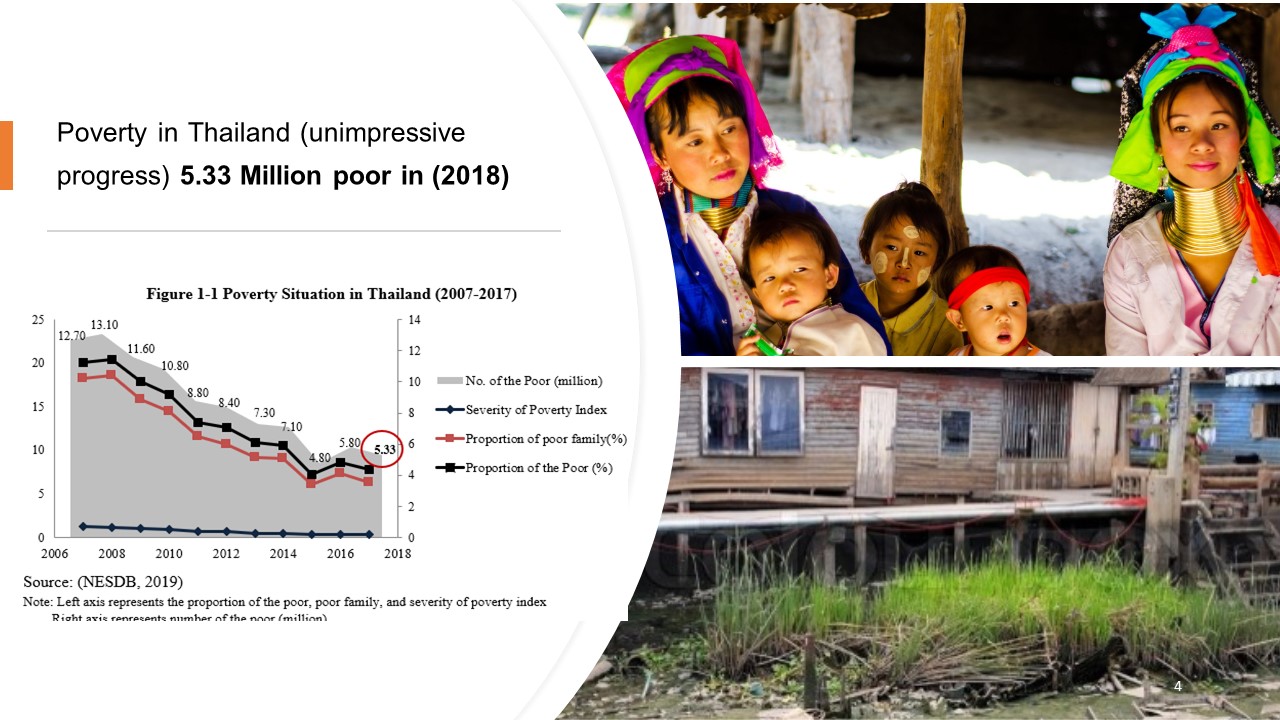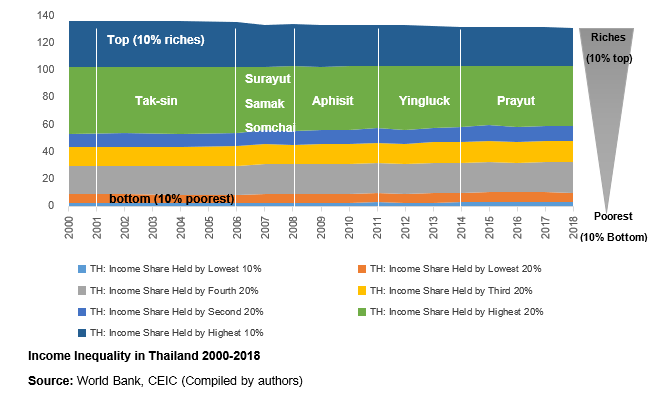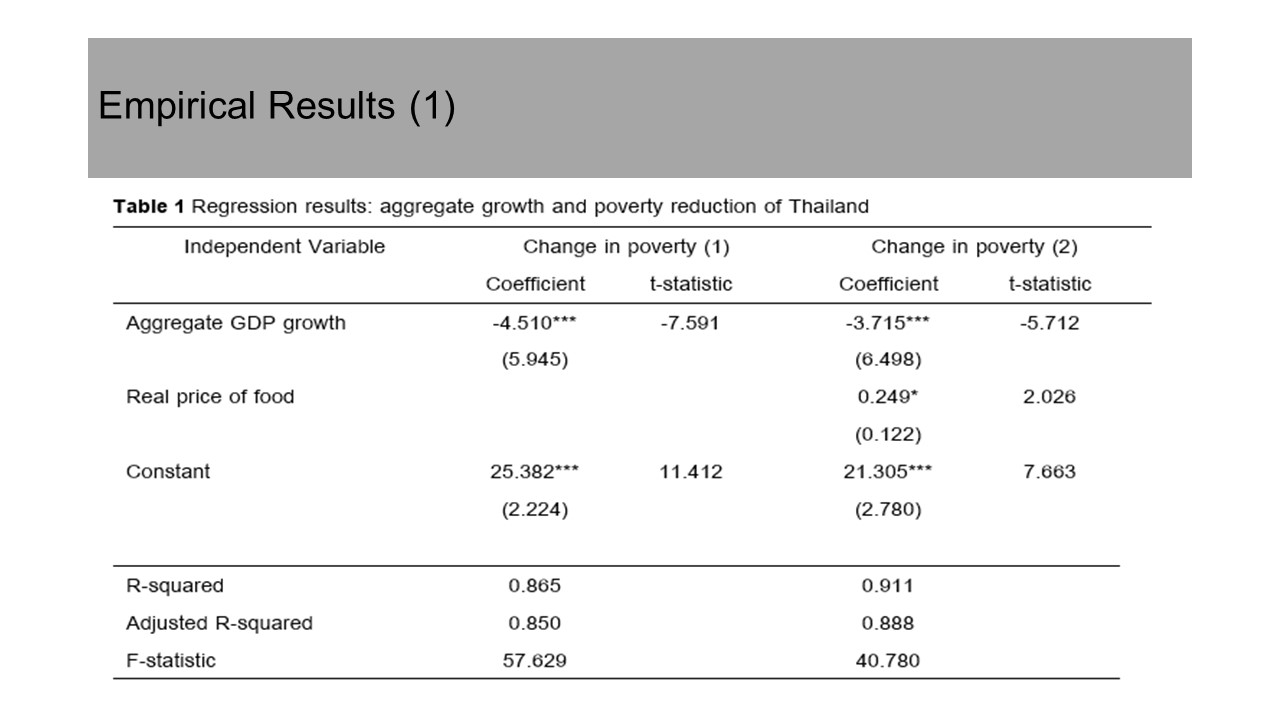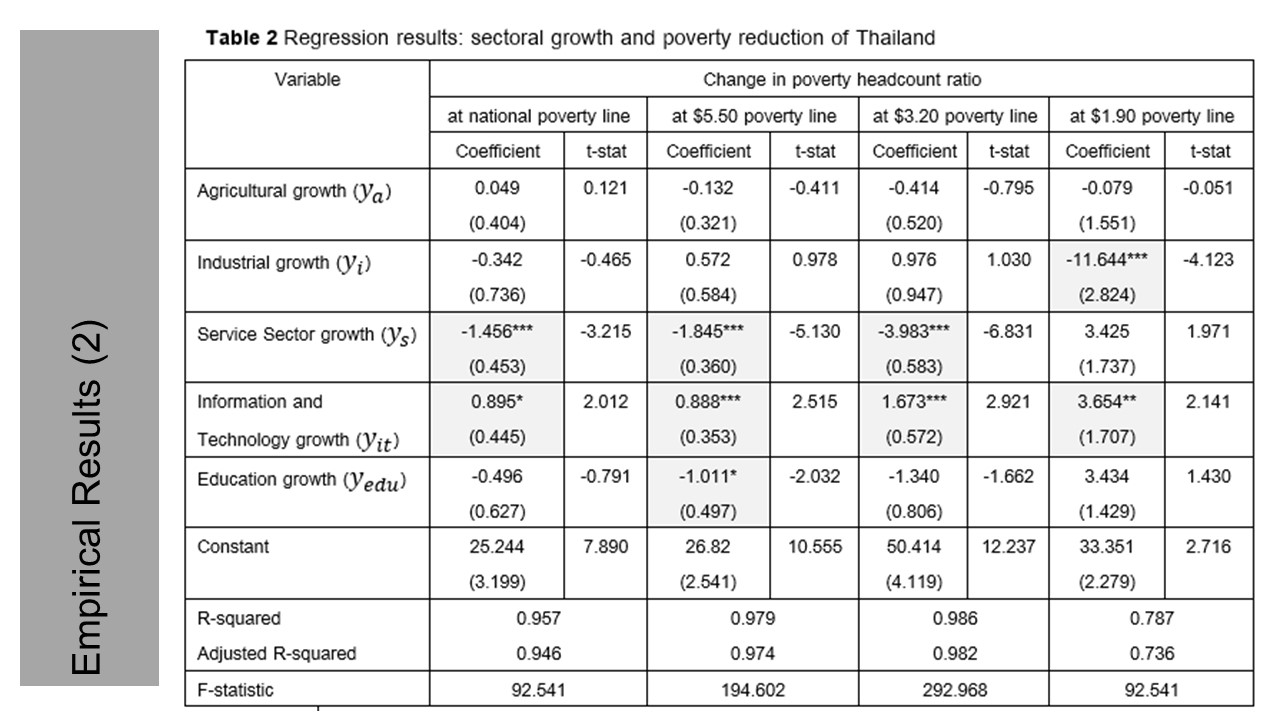DOES THE SECTORAL ECONOMIC GROWTH MAKES THE POOR RICHER? CASE OF THAILAND
เนื้อหา
DOES THE SECTORAL ECONOMIC GROWTH MAKES THE POOR RICHER?
CASE OF THAILAND
Mr.Warawut Ruankham, Phoommiphat Pongpruttikul , and Wang Daoming,
21 January 2021
Abstract
Thailand has magnificent progress during the past ten years in terms of poverty eradication. However, there are still 5.33 million Thai people struggling with poverty in 2017. There are up to 620,540 people living in extreme poverty. This paper aimed to investigate the role of economic growth on poverty reduction from macro-economic perceptive and try to find the empirical evidences to support that the aggregate and sectoral economic growth (agriculture, industrial, and service sector) can help lowering poverty incident. Based on a classical linear regression model, we found that the results are analogous to the theoretical framework in which aggregate and sectoral economic growth play a significant role in poverty reduction. While increasing in food prices worsen the poverty incidence.
1. Introduction
In economics, "Poverty" is a monetary term of income or expenses measurement of people that are below the appropriate standard living of people in society (Word Bank, 2005) or lower than the average income of society known as poverty lines. Those people having income below the standard level of society will be considered as the poor. The word “poor” is a universal language used to call those who lack key capabilities, inadequate income or education, be in poor health, feel powerless, or lack political freedoms. It is believed that the poverty problem is “man-made” (Mandela, 2011), in which the characteristics of poverty faced by the individual, household, society or country. This might be different from their socioeconomic factors, geographical location, and government policies, not a natural selection. Economists have developed the measurement to measure poverty, such as the Headcount Index (HI), the Poverty Gap Index (PGI), and the Severity of Poverty Index. One of the easiest and well-known tool is “Poverty Line”. It is an average line of income or expenditure of people in society. When a person has income or living expenses below the poverty line, that person is considered poor. There are four reasons why poverty need to be measured; first, to keep the poor on the agenda, without poverty measured, the poor would be easily left behind. Second, measuring poverty can identify directly who are the poor and allows the government to set the right target group to alleviate poverty. Third, to monitor and assess policy interventions that are geared towards the poor. And finally, to evaluate the effectiveness of institutions whose goal is to help the poor (World bank, Poverty Manual, All, JH Revision, 2005).
In Economic Development literature, there are two types of poverty problems by its definition. Firstly, “absolute poverty” refers tothe problems when an individual, household, or society does not have access to the basic requirements of life, for instance, food, shelter, clothing, and medicine. These people are extremely struggling with finding a living. Absolute poverty does not consider other factors that are wider than the basic needs of individuals. For example, an individual is facing the absolute poverty problem as they have an inadequate income to afford accommodation. Another dimension of poverty definition is “relative poverty”, it is a problematic situation when individuals are excluded from being able to take part in what is considered the normal, acceptable standards of living in a society. It is a measurement of poverty by comparing the quality of life of one person with the average standard of living of the whole society (Worldbank, Poverty Manual, All, JH Revision, 2005). For instance, an individual might relatively feel poorer to the average majority of people in their village as they have less income comparing to others.
For Thailand, the situation of poverty has improved continuously. The proportion of poor people has decreased continuously for ten years from 21.94 to 4.8 million or declined by 67% within ten years (See Figure 1). It was impressive progress reported in accordance with the World Bank (Wordbank, 2017) indicating that the situation of Thai poverty has been improved outstandingly comparing to neighboring countries. However, the current number of Thai poor people reported by Thailand National Economic and Social Development Board (NESDB) in 2017 has a total of 5.325 million people or 7.87% of the population (NESDB, 2019), which is something Thailand still cannot be proud of and claim its triumph over poverty combat.

Figure 1 Poverty Situation in Thailand (2007-2017)
Source: (NESDB, 2019), pictures retrieved from internet
At the same time, if considering the “extreme poverty” situation in Thailand represented by the number of the poor living below $1.90 and $3.10 per day from 1980-2015 (see figure 2), the number of poor who suffer severe poverty is around 26,980 and 620,540 people respectively (Worldbank, Household survey data, 2015). Even this amount accounted only for 1% of the population, but it claims that the absolute poverty problem still exists. Therefore, no one should be left behind.
.png)
Figure 2 Extreme Poverty Situations in Thailand (1980-2015)
Source: World Bank, Development Research Group, (2015), pictures retrieved from internet
We also know that the poverty is the partial consequences from the income distribution. In case of Thailand, the income inequality is considered the main issue for economic development. We encounter this structural inequality between the rich and the people with low wealth position in our society since the past to present. Figure below illustrates that the income sharing among each income class is not in the balancing distribution. Regardless of which prime ministers, the income of top richest or top 10% and upper middle-income class take more than half of the income of the whole country. Whereas the poor and poorest of the poor received lower that 3% of the whole income. The imbalance structure remains unchanged for almost 20 years since 2000 onward.

All statements mentioned above are only monetary poverty where poverty is measured using the monetary term. Besides, if we consider poverty in a wider and more touching dimension, for example, well-being, health, and education, we can see the poverty problem in the wider dimension. Whether or not these numbers can reflect the actual poverty situation. As a later definition of poverty covered both income and non-income dimensions, it is important not to overlook “non-income poverty”. A later study has put further poverty measurement and has developed other indicators, for example, The Human Poverty Index (HPI) and The Regional Human Achievement Index (RHAI).
The United Nation Development Programme (UNDP), therefore, developed the “Multidimensional Poverty Index (MPI)” to destroy the imitation of income-poverty. MPI was co-designed and launched in 2010 by cooperation with The Human Development Report Office (HDRO) and the Oxford Poverty and Human Development Initiative (OPHI). It provided a new methodology to measure poverty which takes multidimensional health, education, and standard of living into the calculation. As a result, this becomes the new era of poverty analysis that needs to integrate various dimensions into measurement and consequently requires more dimensional approaches to alleviate the problem.
Many approaches to combat poverty have been studied by economists throughout the world including the Poverty Reduction Strategy Paper (PRSP) process suggested by World Bank in 1999 (World Bank, Poverty Manual, All, JH Revision, 2005), a comparative perspective on poverty reduction (Ravallion, 2009), poverty reduction through long-term growth (Warr, 2009), trade liberalization and poverty (Winters et al., 2004), industrialization, employment and poverty (P. Athukorala and K.Sen, 2015), understanding the economic lives of the poor (Abhijit V. Banerjee and Esther Duflo, 2007) and income, health, and well-being around the world (Deaton, 2008). However, the concept of well-being, poverty profile, and determinants of poverty of each country are differ based on different demographical presentations, economic characteristics, socioeconomic factors, and government policies. Therefore, suitable approaches to end poverty need to be well-designed, target the right spot, and sustainable.
This paper, therefore, aimed to find evidence to support our hypothesis if the long-term economic growth and sectoral economic growth (agriculture, industrial, and service sector growth) has significantly relation to poverty reduction in Thailand. The study will benefit multiple stakeholders whose goals to end poverty. Firstly, this study will support the PRSP of the World Bank, and help improve the capacity of analysts, researchers, and statisticians in developing countries especially in the ASEAN region. Secondly, the Thai government and the National Economic and Social Development Board (NESDB) whose main purpose to develop and monitor the economic and social development of the country. Lastly, this study will contribute to those passionate researchers throughout the globe who engaging the field of poverty and inequality.
3. Methodology
This paper aimed to find evidence to support that poverty reduction is driven by aggregate and sectoral economic growth, possibly influenced by its sectoral composition and further by the relative price of food. The data consisted number of the poor by the National Economic and Social Development Board of Thailand from 2007-2018, real and sectoral GDP growth, and the relative price of food by the Ministry of Commerce. According to Peter War (2018), the model classification as expressed as the following expressions;
3.1 Nexus of the Poverty and Aggregate Growth
P=NpN=φ(Y,RF) ![]()
(3.1) Where, p![]() = poverty headcount ratio
= poverty headcount ratio
Np![]() = Total number people in poverty
= Total number people in poverty
N![]() = Total number of the whole population
= Total number of the whole population
Y![]() = Real income per unit of population
= Real income per unit of population
RF![]() = The relative price of food
= The relative price of food
To indicate the marginal effects of real income and relative price effect, we take the total differentiating
3.1 and obtain the following expression,
dP=φYYy + φRdRF![]()
(3.2) Where, dP![]() = represents the change in poverty incidence
= represents the change in poverty incidence
dRF![]() = represents the change in the real price of food
= represents the change in the real price of food
y=dY/Y![]() is the growth rate of aggregate real income per person
is the growth rate of aggregate real income per person
Finally, we estimate relationships of the change in poverty to the change in two determinants:
dP=a+by+cd(RF)![]()
(3.3) And test whether the coefficients b and c are significantly different from zero.
3.2 Poverty and Sectoral Growth
Whether the sectoral composition of economic growth is significant for poverty reduction can be investigated as follows. The level of real GDP per person is given by:
Y=Ya+Yi+Ys+Yit+Yedu![]()
(3.4) Where Ya,Yi,Ys,Yit ,Yedu and denote value-added (contribution to GDP) per person in the total population, measured at constant prices, in agriculture, industry, services, information and technology, and education respectively. The overall real rate of growth per person can be decomposed into its sectoral components from:
y=Haya+Hiyi+Hsys+Hityit+Heduyedu![]()
(3.5) Where Hk =YkY, k=a,i,s,it,edu, denotes the share of sector k in GDP.
(3.6) dP=a+baHaya+biHiyi+bsHsys+bitHityit+beHeduyedu+cdRF
4. Empirical Results
The regression represented in table 4.1 and 4.2 summarized the empirical results which are analogous to support the theoretical framework discussed above. First, we discussed the role of aggregate economic growth and poverty reduction in Thailand using annual data from 1993-2019. Prior to the result interpretation, regression models had satisfied the classical linear regression assumptions in which there is no multicollinearity, heteroscedasticity, and autocorrelation. For the detection of multicollinearity, pairwise correlation and Variance Inflation Factors (VIF) had been adopted to ensure that correlation among the independent variable does not exists (VIF of around 1.6025 which is less than 5, thus we concluded that there is no multicollinearity problem). The results also passed the white’s heteroscedasticity test in which the null hypothesis of homoscedasticity was accepted (F-statistic 2.453, Prob. F (5,5) 0.1735). Durbin-Watson stat is 1.8743 which is located close to 2, it is concluded no positive and negative autocorrelation.
Note: Standard errors in parentheses; * Denotes confidence level at 90%; ** Denotes confidence level at 95%; *** Denotes confidence level at 99%
The (1) model in table 1, we firstly discuss the effect of aggregate GDP growth and change in poverty. Results from Thailand suggested that when aggregate economic growth increases, the poverty (or number of the poor) is reduced by 4.510 percentage points significantly. By the rule of thumb, we knew that this is due to the spillover of the economic expansion into the employment and labor income. Then, in the second model (2) we estimated equation 3.2 to observe if the real food price and change in aggregate economic growth simultaneously affect to the poverty. Results are unsurprising, the two components affected poverty significantly. On one hand, the aggregate economic growth lowers the poverty. On the other hand, when consider the price effect to the poverty, the real price of food (taken as a cost of living of people) does worsen the purchasing power of the poor and caused poverty incidence to increase. We then can conclude that the aggregate economic growth can lower poverty, whereas the higher food price worsens the poverty incident in Thailand.
As equation (3.6), we estimated the nexus between poverty and sectoral economic growth. The results showed in table 2 distinguished the results for three groups of the poor by the different poverty line. Namely, the poor at the national poverty line, $5.50 poverty line, and the poor at $3.20 poverty line. While the last column represents the extremely poor citizen who live under $1.90 poverty line.
For the effect of Agricultural growth on the poverty reduction, the estimated coefficients of agricultural sector were not found significant to the poverty (under the national poverty). The results yielded the positive side showed that the increase in agriculture economy worsen the poverty incidence. This is in line with the current problems of Thai farmers. A group of studies noticed that Thai farmers encountered severe debt problems, weather condition, and yield price fluctuation (Fabrizio Bresciani, et al., 2002; Soontaranurak, K., & Dawson, P., 2015; Laosutsan, P., Shivakoti, G., & Soni, P., 2019; Sukanlaya Choenkwan, Jefferson Metz Fox, & A. Terry Rambo., 2014; Sukanlaya Choenkwan, et al., 2016). Although there is an increase in production, the debt of the farmers remains the same or even increase, which comes from the existing debt, rising interest rates for loans which caused a debt repayment ability. Also, this creates additional debt for production in the next. Then the problem of poverty does not decrease. However, if we have a look at the poor by the poverty line at $5.50, $3.20, and $1.90 a day, we found that the expansion in agriculture are positively impacted to those who live their life lower than $5.5, $3.2, and $1.9 a day. Which means that most of the poor in Thailand who are still in agriculture sector were benefited by the expansion in agriculture economy. We conclude that the agricultural growth is not the key factor for poverty reduction for Thailand.
While industrial growth did not impact to the poor at national poverty line, $5.5, and $3.2 poverty line. This is because; (i) The structure of Thailand industrial sector- that more than half of investment value comes from the foreign direct investment. This benefited only unskilled labor. This argument claimed by the results in the last column that it positively benefits to those extremely poor group significantly. (ii) The shrinking in number of Thai labors in manufacturing which arise from various factor, i.e., aging labor, insufficient number of unskilled labors, migrant workers from neighboring countries (Mizuno, A., 2020), etc. Currently, most of the labors in Thai manufacturing come from the neighboring countries such as Myanmar Lao and Cambodia (Mizuno, A., 2020). (iii) Due to the wage imbalance between Thailand and its neighbors, many foreign direct investments were encouraged to reallocate their production base to neighboring countries instead. Therefore, even the growth in the industrial sector increases, it does not spill benefit significantly to reduce poverty. Service sector growth, the growth of services economy was associated with reductions in poverty incidence in Thailand significantly. This is because the service sector involves several economic activities (Booth, A.,2019), employs high skilled labor with higher return. The service sector is considered as a high value-added economic activity which provides positive externality spillover to other related industries as well. Our results claimed that service sector growth benefits to most of the poor except the extremely poor. Comparing to other types of the poor, this might because the extremely poor people may not be able to access to service sector yet. Or, the service sector does not reach the bottom group of the poor yet.
This paper found that Information and Technology growth surprisingly not lower the poverty problems. In contrast, it generates more poverty incidence. This implies that the poor may be not able to access in IT sector. IT devices might be unaffordable to the poor. Or, the IT sector job might require those with higher skill and education which are the key resources that the poor does not have.
Lastly, this paper found that the education growth helps lower amount of the poor significantly. By the rule of thumb, the foundation of success is the education. Accessing to education at least guarantee that the poor can access to job market and seek for the job.
5. Conclusion and Discussion
This paper was developed to find empirical evidence to support the theoretical framework introduced by War, Peter G. (2018). The theoretical framework follows that aggregate and sectoral economic growth can lower the poverty incident. This paper was tested with this framework by constructing a classical linear regression model incorporating basic violation assumption diagnosis to ensure that the results are “Best Linear Unbiased Estimator (BLUE)” and independent of multicollinearity, heteroscedasticity, and autocorrelation. We found similar results to War Peter (2018); Northrop, E. (1988); Hainsworth, G. (1979); that the aggregate growth does reduce the extreme poverty in Thailand. Comparing to Peter War (2018), we found additional evidences. First, we supported finding of Peter War (2018) that the real price of food has impacts the poverty incidence and the poor’s purchasing power. Second, we agreed that the sectoral growth affected the poverty incidence in Thailand, excepted the that the agricultural growth might affected some group of the poor. The main reason agriculture growth does not lower the poverty is because of the severe debt-cycle and repayment ability of Thai agriculturists and the price fluctuation in the agriculture sector (both product price and inputs price) that worsen debt-cycle situation of farmers. Our result in line with De Janvry, A., & Sadoulet, E. (2010) that argricultural growth might somehow not able to lower poverty due to the differernce regional contexts, rural conditions, and limitations. For the futher studies, we suggested to take the greater look into more regional data. As well as, using other method to discuuss how the service sector growth can lower the poverty incidence in Thailand.
Bibliography
Abhijit V. Banerjee and Esther Duflo. (2007). The Economic Lives of the Poor. Journal of Economic Perspectives, Volume 21, Number 1—Winter 2007, 141–167.
Astia Dendi et.al. (2004). Alleviating Poverty through Local Economic Development Lessons from Nusa Tenggara. Tenggara Provinces: PROMIS-NT.
Bassford, T. (2010). Breaking the Cycle of Poverty through Holistic Sustainable Community Development. Significant Matters, Inc. .
Booth, A. (2019). What Have We Learned? In Living Standards in Southeast Asia: Changes over the Long Twentieth Century, 1900-2015 (pp. 263-284). Amsterdam: Amsterdam University Press. doi:10.2307/j.ctvsr51jr.13
Casse, T., & Jensen, S. (2009). Do We Understand the Linkages between Economic Growth, Poverty Targets and Poverty Reduction? Review of African Political Economy, 36(122), 539-553. Retrieved November 6, 2020, from http://www.jstor.org/stable/27756310
CSF. (2016). Time for a holistic approach to rural poverty. Retrieved from Committee on World Food Security: http://www.fao.org/cfs/home/blog/blog- articles/article/en/c/447515/
CVBN. (2012). A HOLISTIC APPROACH TO POVERTY REDUCTION: LIVELIHOOD IMPROVEMENT GROUP MECHANISM. Retrieved from Value- Chian Capacity Building Network: http://vcbnetwork.org/library/a-holistic-approach-to-poverty-reduction-livelihood-improvement-group-mechanism
Deaton, A. (2008). Income, Health, and Well-Being around the World: Evidence from the Gallup World Poll. Journal of Economic Perspectives, Volume 22, Number 2—Spring 2008, 53–72.
De Janvry, A., & Sadoulet, E. (2010). Agricultural Growth and Poverty Reduction: Additional Evidence. The World Bank Research Observer, 25(1), 1-20. Retrieved November 6, 2020, from http://www.jstor.org/stable/40649308
Eegunlusi, T. R. (2016). Africa, Poverty and Forces of Change: A Holistic Approach to Perceiving and Addressing Poverty in Africa. Scietific Research Publishing, Open Journal of Philosophy 06(04):368-391.
ESI. (2011). Local Economic Development Tools, An introduction for Municipalitiesand Local Economic Service Providers in Bosnia and Herzegovina. European Stability Initiative -ESI.
Fabrizio Bresciani, Feder, G., Daniel O. Gilligan, Jacoby, H., Onchan, T., & Jaime Quizon. (2002). Weathering the Storm: The Impact of the East Asian Crisis on Farm Households in Indonesia and Thailand. The World Bank Research Observer, 17(1), 1-20.
Hayes, J. (2005). prosperitynow. Retrieved from prosperitynow: https://www.prosperitynow.org/blog/how-use-behavioral-science-help-end-poverty
Hainsworth, G. (1979). Economic Growth and Poverty in Southeast Asia: Malaysia, Indonesia and the Philippines. Pacific Affairs, 52(1), 5-41. doi:10.2307/2757764
Kakwani, N., and Medhi Krongkaew. (1998). Poverty in Thailand: Defining, Measuring and Analyzing. Working Paper No.4, Asian Development Bank and Development Evaluation Division, NESDB.
osutsan, P., Shivakoti, G., & Soni, P. (2019). Factors Influencing the Adoption of Good Agricultural Practices and Export Decision of Thailand’s Vegetable Farmers. International Journal of the Commons, 13(2), 867-880. doi:10.2307/26819574
Mahlalela, S. (2014). Investigating the Role of LED as a Tool for Poverty Alleviation in Mbombela Municipality. Johannesburg: Faculty of Engineering and Built Environment,University of Witwatersrand.
Mandela, N. (2011). Nelson Mandela by Himself: The Authorised Book of Quotations.
Mizuno, A. (2020). Labour Migration and Relocation of Apparel Production between Thailand and Myanmar. Journal of Southeast Asian Economies, 37(2), 181-198. doi:10.2307/26938872
rthrop, E. (1988). Economic Growth and Poverty Reductions: Important Mitigating Factors. Eastern Economic Journal, 14(4), 349-356. Retrieved November 6, 2020, from http://www.jstor.org/stable/40325235
NESDB. (2019). Socio-Economic Survey of Households. Bangkok: National Statistical Office.
P. Athukorala and K.Sen. (2015). Industrialisation, Employment and Poverty. Forthcoming in Michael Tribe and John Weiss (eds.), Routledge Handbook of Industrial, pp. 84- 95.
Ravallion, M. (2009). A Comparative Perspective in Brazil, China and India. Policy Research Working Paper 5080.
Soontaranurak, K., & Dawson, P. (2015). Rubber Acreage Supply Response In Thailand: A Cointegration Approach. The Journal of Developing Areas, 49(2), 23-38.
Somporn Isvilanonda, Ahmad, A., & Hossain, M. (2000). Recent Changes in Thailand's Rural Economy: Evidence from Six Villages. Economic and Political Weekly, 35(52/53), 4644-4649.
Sukanlaya Choenkwan, Jefferson Metz Fox, & A. Terry Rambo. (2014). Agriculture in the Mountains of Northeastern Thailand: Current Situation and Prospects for Development. Mountain Research and Development, 34(2), 95-106.
Sukanlaya Choenkwan, Arunee Promkhambut, Fukui Hayao, & A. Terry Rambo. (2016). Does Agrotourism Benefit Mountain Farmers? A Case Study in Phu Ruea District, Northeast Thailand. Mountain Research and Development, 36(2), 162-172.
UnitedNation. (2017). Urging Holistic Approach to End Poverty, Non-governmental Groups Press Social Development Commission to Address Broad Concerns of Most Vulnerable. United Nations.
Warr, P. (2009). Poverty Reduction through Long-term Growth: The Thai Experience. Asian Economic Papers, 51-76.
Warr, P. (2018). Poverty Reduction and Economic Growth In Southeast Asia. Thammasat Economic Journal, 1-31.
Winters et al. (2004, March). Trade Liberalization and Poverty:The Evidence So Far. Journal of Economic Literature, Vol. XLII , pp. 72–115.
Wordbank. (2017). It’s Time for Thailand to Get Back on Track. world bank group.
WorldBank. (2003). The Poverty Reduction Strategy Initiative. Washington, D.C.: World Bank.
Worldbank. (2005). Poverty Manual, All, JH Revision. world bank group.
Worldbank. (2015). Household survey data. World Bank, Development Research Group.
worldbank. (March 29, 2017). It’s Time for Thailand to Get Back on Track. world bank group.
***********************************
.png)
ดร.ภูมิพัฒณ์ พงศ์พฤฒิกุล
อาจารย์ประจำวิทยาลัยบริหารธุรกิจนวัตกรรมและการบัญชี มหาวิทยาลัยธุรกิจบัณฑิตย์
ผู้สนใจศึกษาด้านเศรษฐิจจีน บริหารธุรกิจระหว่างประเทศ ธุรกิจและนวัตกรรม
.png)
อ.วราวุฒิ เรือนคำ
อาจารย์ประจำสาขาวิชาเศรษฐศาสตร์ สำนักวิชาการจัดการ
มหาวิทยาลัยแม่ฟ้าหลวง ผู้สนใจการวิจัยด้าน นโยบายเศรษฐกิจ เศรษฐศาสตร์การพัฒนา
และเศรษฐมิติประยุกต์
ผู้วิเคราะห์ :
Dr.Phoommiphat Pongpruttikul
ปีที่วิเคราะห์
: 2021



